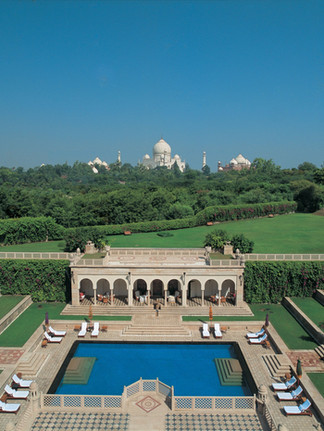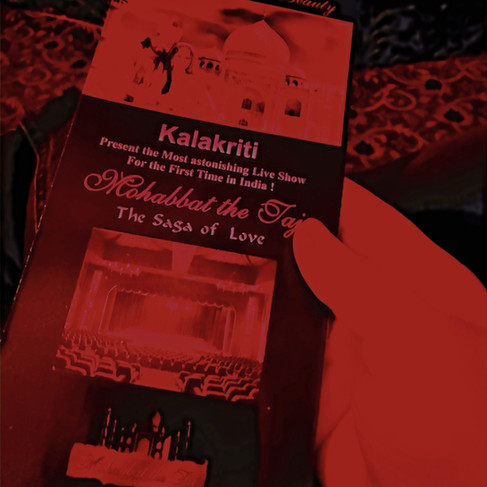How to Plan a Memorable Visit to the Taj Mahal in 2025
Updated: 6 days ago
Visiting the Taj Mahal had been on our family’s bucket list for a while. As someone who grew up in India but has lived abroad for many years, I knew this trip would be both nostalgic and new for me. For my daughter, it was her first time seeing this iconic monument, and we wanted to make it a memorable experience.

Getting to Agra
We started our journey by flying into New Delhi, the most convenient hub for international travelers. We spent the night in Delhi by the airport at the Aloft Aerocity.
The next morning, after an amazing buffet breakfast at the hotel, we rented a car with a driver and made the 3-4 hour drive to Agra via the Yamuna Expressway. The roads were surprisingly good, though traffic near Delhi can slow you down depending on when you leave.
Having a driver stay with us overnight was a practical decision—it made our trip more flexible and allowed us to take breaks whenever we needed. The ability to stop for chai or stretch our legs made the journey feel relaxed.
We rented a car from Zed Car Rental & Lease Co. For questions, you can Whatsapp their travel desk at +91-98103.70010.
For us - The cost for 2-day overnight trip (car+ driver) was under ₹20,000 (USD $235), which felt reasonable for the convenience. This trip cost covered 650 kilometers (403 miles), driver allowance, toll tax, gas and parking. We did not have to pay for the driver's food or overnight stay - he managed it himself within the allowance.
Staying in Agra
We chose the ITC Mughal for our stay in Agra, which turned out to be an excellent decision for our family. The hotel is spacious, comfortable, and conveniently located. Its lush gardens and inviting pool area provided a lovely respite after a long day of travel. The ITC Mughal met all our needs without breaking the bank. We paid about $250 a night that included a breakfast buffet.
Our guide did mention that the Oberoi Amarvilas, the closest luxurious hotel to the Taj Mahal, with its suites offering breathtaking views of the iconic monument, is another exceptional choice. While that sounded incredible, it came with a hefty price tag at USD $1000+ a night, a two-night minimum and no breakfast included.
The Taj Mahal Experience
Arriving and Tickets
Once in Agra, our driver parked at a designated lot, and we walked to the ticketing area. There’s an option halfway to take a golf cart to the entrance, but we decided to walk, enjoying the lively atmosphere. It’s worth noting that the area can get very crowded, so if you’re traveling with young kids or need assistance, the carts might be a better choice as long as you are willing to wait in a long line to get the ride.

We had arranged for our guide to purchase tickets in advance, which made things much easier. Without an Aadhar card or an Indian phone number, buying tickets can be challenging, so having a guide handle this is a good idea. The difference in ticket prices is significant—Indian passport holders and OCI cardholders pay less compared to foreign travelers. Make sure to carry enough Indian rupees for tips and incidental expenses.
We paid ₹250 (USD $3) per person per OCI passport ticket - which our guide purchased for us online. For foreigners, each ticket cost $15. Kids under 15 are free. Proof of age and citizenship need to be shown.
Walking Through the Gate

Passing through the large red sandstone gate and catching the first glimpse of the Taj Mahal is a moment that takes your breath away. It’s not just the beauty of the monument—it’s the feeling of seeing something so iconic finally materialize in front of you. My daughter’s awe and wonder made the moment even more special. It’s a sight that truly captures your attention, and we paused for several minutes just to take it all in.
Built by Shah Jahan as a symbol of love for his wife Mumtaz Mahal, it’s a breathtaking reminder of devotion, artistry, and history. Twenty two years, thousands of artisans, and an undying legacy—this visit was a journey into a love story etched in white marble!
The Main Mausoleum
Inside the Taj complex, you’ll find the mausoleum, gardens, fountains and several other structures. The mausoleum itself is stunning, with intricate marble inlays and carvings that feel quite extraordinary. If you choose a ticket that allows access to the cenotaph area, you’ll see the replicas of Shah Jahan and Mumtaz Mahal’s tombs. The real graves are located underground, and you can visit them if desired—ask your guide for assistance.
While the crowd inside the mausoleum can be overwhelming, we found that having a guide helped us navigate efficiently and learn about the fascinating details of the architecture and history. You can also request your guide to focus more on the Taj rather than other structures, tailoring the experience to your preferences.
Looking for a guide? Feel free to reach out to our guide - Deepak Rathore: +91.97588.07729.
He spoke native Hindi, fluent Spanish and OK-ish English. We got his information through a friend and we communicated with him via Whatsapp a month before our trip. He was great at arranging everything, met us at the hotel, saved us money and helped us navigate Agra! I hope he takes on a bigger role and becomes a tour operator someday - he was great at that.
To Hire a Photographer or Not?
We didn’t hire one of the professional photographers wandering around the Taj Mahal. Instead, our guide graciously helped us capture some family photos. While they weren’t professional-level, they turned out pretty good and felt more personal. For those seeking polished or Instagram-perfect shots, hiring a photographer could be worth considering.
Entrance Gates and Security
The Taj Mahal has three entrance gates: East, West, and South. As of 2025, the South Gate remains permanently closed for tourists, a change implemented after the COVID-19 pandemic. The East Gate is popular among foreign tourists due to generally shorter queues, except at sunrise. The West Gate often sees longer lines, predominantly with domestic visitors. For a smoother experience, especially during peak hours, the East Gate is recommended.
Be prepared for security checks; items such as drones, tripods, food, and large bags are prohibited inside the complex. It’s advisable to travel light and familiarize yourself with the list of restricted items before your visit.
Shoe Covers and Footwear
Visitors are required to remove their shoes or wear shoe covers when entering the main mausoleum to preserve the marble flooring. For foreign tourists, shoe covers are included with the high-value tickets and can be collected at the entrance. However, Indian citizens may need to purchase shoe covers separately. Vendors outside the Taj Mahal offer shoe covers for a nominal price, typically around ₹20 (USD 0.25) per pair. We found it convenient to acquire these before entering. Yes - the guide paid for them and then we paid him later along with his fee of around $25 for about two hours to see the Taj.
Night Viewing Opportunities
Experiencing the Taj Mahal under the moonlight is a unique opportunity available only during full moon nights and two days before and after. This exclusive experience allows visitors to witness the monument bathed in the ethereal glow of the moon. However, the actual viewing time is brief, and given a choice, daytime visits are more rewarding. Tickets for night viewing are limited and must be purchased at least 24 hours in advance. Each night, eight batches of 50 visitors are allowed, with each batch allotted 30 minutes between 8:30 PM and 12:30 AM. It’s important to note that night viewing is not available during the month of Ramadan and on Fridays.
Sunrise Viewing
We initially considered a sunrise visit to the Taj Mahal, but recent reports of fog obscuring the view made us rethink. If you do plan a morning visit, it’s better to go after 7 AM, as visibility improves significantly by then. Early mornings can also be less crowded, making for a more serene experience.
Souvenirs
There are spots within and around the Taj complex to buy small souvenirs, like marble miniatures and other handicrafts. While we didn’t buy anything, our guide pointed out these shops in case we were interested. If you’d like to browse, let your guide know—they can direct you to the best options.
The Taj Mahal Evening Show
After our visit to the Taj Mahal, we attended an evening show at 7 PM that dramatized the history and legend of the monument. While the music and dance costumes were vibrant, the acting left much to be desired. It’s an optional activity that adds variety to your trip but manage your expectations if you choose to attend. Tickets need to be purchased in advance, so plan accordingly. For language options, my daughter and I chose the English audio, which worked well for us, while my husband enjoyed the Hindi version. We paid ₹2,500 (USD $30) per ticket for the Platinum level. In retrospect, we could have chosen seats that were at Gold level - A little bit behind. See details here.
The Taj Mahal is undoubtedly an experience that stays with you. For us, it wasn’t just about the beauty of the monument but also about the stories, the history, and the shared experience as a family. While there were moments of chaos and exhaustion, it was worth every bit of effort. If you’re planning a visit, go with an open mind, some patience, and the willingness to embrace the unexpected—it’s all part of the adventure.









































